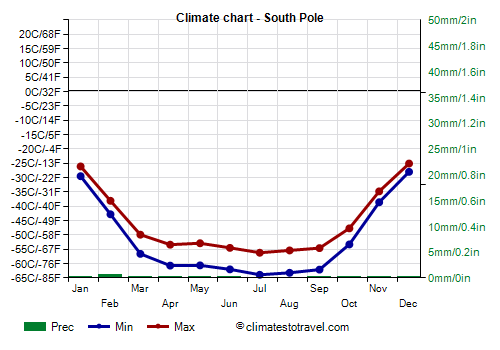Select units of measurement for the temperature and rainfall tables (metric or imperial).
Average weather, temperature, rainfall, sunshine hours

At the South Pole there is a
polar climate, with extremely low temperatures, always below freezing, frequent wind, frequent but light snowfall, and with six months of night, sometimes illuminated by the aurora australis, and six months of sunlight.
The South Pole, the southernmost point of the Planet, at 90 degrees south latitude, is located on a frozen plateau at 2,835 meters (9,300 feet) above sea level. The American base
Amundsen–Scott is located there. It is one of the coldest places on Earth, but not the coldest, given that the Antarctic continent is not exactly centered on the pole, so there is a vast area (where the Vostok and Dome C stations are located), which it is further away from the sea and is even colder, also because the altitude is slightly higher (from 3,200 to 3,500 metres - 10,500 to 11,500 ft).
Average annual
temperature is -48.65 °C (-55.5 °F), ranging from about -26.5 °C (-15.5 °F) in December to about -60 °C (-76 °F) in July.
The two mildest months by far are December and January, then, as the sun descends above the horizon, the temperature decreases rapidly starting from February. However, in the cold period, from April to September, also due to the change in atmospheric circulation, the temperature stabilizes, so much so that from April to July it decreases by only 3 degrees Celsius (5.5 °F).
The cold record is -82.8 °C (-117 °F), set in June 1982. The heat record is -12.3 °C (-9.85 °F), set on Christmas day 2011.
Here are the average temperatures.
South Pole - Average temperatures (2000-2020) |
| Month | Min | Max | Mean |
|---|
| January | -29.5 | -26.1 | -27.8 |
|---|
| February | -42.8 | -38.1 | -40.4 |
|---|
| March | -56.6 | -49.9 | -53.2 |
|---|
| April | -60.7 | -53.4 | -57 |
|---|
| May | -60.6 | -52.9 | -56.8 |
|---|
| June | -62 | -54.5 | -58.2 |
|---|
| July | -63.9 | -56.2 | -60 |
|---|
| August | -63.2 | -55.4 | -59.3 |
|---|
| September | -62.1 | -54.6 | -58.4 |
|---|
| October | -53.3 | -47.7 | -50.5 |
|---|
| November | -38.6 | -34.8 | -36.7 |
|---|
| December | -28 | -25.1 | -26.6 |
|---|
| Year | -51.8 | -45.7 | -48.65 |
|---|
The altitude is so high because a thick
ice layer has formed over the millennia. If there were no ice, the South Pole would be almost at sea level.
Ice accumulation from one year to the next is equivalent to approximately 20 cm (8 in) per year. Ice is snow deposited on the ground, which then compresses due to gravity.
In 2010, it was hypothesized that Roald Amundsen's tent, pitched in December 1911, so a century earlier, was buried about 17 meters (55 ft) below the surface of the ice.
The amount of
snow that actually falls can only be estimated, because some of it is carried away by the wind. On average, there are 203 days with snow per year. Given the low temperatures, these are mostly small ice crystals, called "diamond dust", which can form even with clear skies, due to direct condensation of the little humidity present in the air. More rarely, snow can fall in the form of sleet, while actual snowflakes are rarely observed and generally only in summer. However, the snow does not melt because the temperature never rises above freezing.
The
precipitation measured at the South Pole is decidedly low. In fact, with an average precipitation of just over 2 millimeters per year, the South Pole is one of the driest places on the planet. Here is the average precipitation.
South Pole - Average precipitation| Month | Days |
|---|
| January | 0 | 0 |
|---|
| February | 1 | 0 |
|---|
| March | 0 | 0 |
|---|
| April | 0 | 0 |
|---|
| May | 0 | 0 |
|---|
| June | 0 | 0 |
|---|
| July | 0 | 0 |
|---|
| August | 0 | 0 |
|---|
| September | 0 | 0 |
|---|
| October | 0 | 0 |
|---|
| November | 0 | 0 |
|---|
| December | 0 | 0 |
|---|
| Year | 0 | 2 |
|---|
However, the estimated real quantity is around 70 mm (2.75 in) per year. This makes it clear that measuring precipitation in these conditions, with the light snow carried away by the wind, is very difficult.
It is therefore not surprising that research station buildings are designed to avoid being buried by snow, also because they suffer from the additional effect of the accumulation of wind-blown snow.
The
wind at the South Pole, and in general on the central plateau of Antarctica, blows often, but the gusts are less intense than in the peripheral areas, where the terrible katabatic winds blow, which rush towards the ocean with hurricane force. At the South Pole, the wind blows at an average of 20 kph (12.5 mph), and the strongest gust ever recorded was 93 kph (58 mph). In strong wind conditions, with snow raised by the wind, visibility is reduced to zero.
The ice sheet is not stationary, but
is moving about 10 meters (33 ft) per year, in the direction of the Weddell Sea. This means that the research station and the weather station also move with it.
The so-called
Ceremonial South Pole, which indicates the real position of the geographic South Pole, with a metal sphere mounted on a pole, a sign and the flags of the countries adhering to the Antarctic Treaty, must therefore be periodically moved.

At the South Pole, as at the North Pole, there are
six months of day and six months of night. The sun rises on the spring equinox, which in the southern hemisphere is September 21st or 22nd depending on the year. Unlike the rest of the Earth, the sun remains at the same height over the course of a day, and gradually rises over the weeks and months, until it reaches its maximum height above the horizon (about 23 and a half degrees) on the day of the summer solstice, on December 21st or 22nd, and then gradually decreases and sets at the autumn equinox, on March 20th.
However, in reality the dark period is shorter, because for a few weeks, the dawn lights are observed in spring and the dusk lights in autumn.

The
sunshine amount at the South Pole is good overall, given that there are 2,700 hours of sunshine per year. In the six months when the sun is above the horizon, the sky is mostly clear. Here is the average number of hours of sunshine per day.
South Pole - Sunshine hours| Month | Average | Total |
|---|
| January | 16 | 495 |
|---|
| February | 14.5 | 410 |
|---|
| March | 6.5 | 195 |
|---|
| April | 0 | 0 |
|---|
| May | 0 | 0 |
|---|
| June | 0 | 0 |
|---|
| July | 0 | 0 |
|---|
| August | 0 | 0 |
|---|
| September | 1 | 35 |
|---|
| October | 12.5 | 390 |
|---|
| November | 18.5 | 560 |
|---|
| December | 20 | 615 |
|---|
| Year | 7.4 | 2700 |
|---|